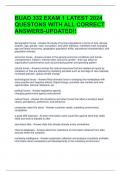BUAD 332 EXAM 1 LATEST 2024
QUESTONS WITH ALL CORRECT
ANSWERS-UPDATED!!
demographic forces - Answer-the study of human populations in terms of size, density,
location, age, gender, race, occupation, and other statistics. marketers track changing
age and family structures, geographic population shifts, educational characteristics, and
population diversity
economic forces - Answer-consist of the general economic conditions and trends -
unemployment, inflation, interest rates, economic growth - that may affect an
organization's performance such as purchasing power and spending pattern
natural forces - Answer-involves the natural resources that are needed as inputs by
marketers or that are affected by marketing activities such as shortage of raw materials,
increased pollution, global climate change
technological forces - Answer-Most dramatic force in changing the marketplace with
many positive and negative effects. Rapid change, provides new markets and new
opportunities, Internet, Medicine, etc.
political forces - Answer-legislative agenda
changing government agency enforcement
cultural foces - Answer-the insulations and other forces that affect a society's basic
values, perceptions, preference, and behaviors
companies need info about - Answer-customer needs, marketing environment,
competition
a good MIS balances - Answer-information users would like against what they really
need and what is feasible to offer
secondary data - Answer-data that already already exists somewhere
internal databases - Answer-electronic collections of information obtained from data
sources within the company
marketing intelligence - Answer-systematic collection and analysis of publicity available
information about competitors and developments in the marketing environment
, primary data - Answer-information created specifically for the purpose at hand
marketing research - Answer-the systematic design, collection, analysis, and reporting
of data relevant to a specific marketing situation facing an organization
Exploratory Research - Answer-gather preliminary information that will help define the
problem and suggest hypotheses
descriptive research - Answer-describes things (e.g. market potential for a product,
demographics, and attitudes)
casual research - Answer-test hypotheses about cause-and-effect relationships
secondary data - Answer-information that already exists somewhere, having been
collected for another purpose
types of secondary data - Answer-internal databases, commercial data services,
government sources
Primary Data Collection - Answer--Consists of information collected for the specific
purpose at hand
-Must be relevant, accurate, current, and unbiased
qualitative research - Answer-observation, in-depth interviews, focus groups, social
media
quantitative research - Answer-surveys, experiments, "big data"
unobtrusive observation - Answer-do not know you're being observed
obtrusive observation - Answer-know you're being observed
pros of observation - Answer-record what actually happened
avoids problems of measuring attitudes or motivations
technology can facilitate detailed data gathering
cons of observation - Answer--Attitudes and motivations cannot be determined
-Some behavior cannot be observed because it is unethical or illegal
most popular way to obtain primary data - Answer-survey research, most specifically
satisfaction surveys
quantitive research methods - Answer-telephone, mail, face-to-face, electronic. relies
heavily on scaled/categorized responses
Pros of quantitative methods - Answer-versatile




